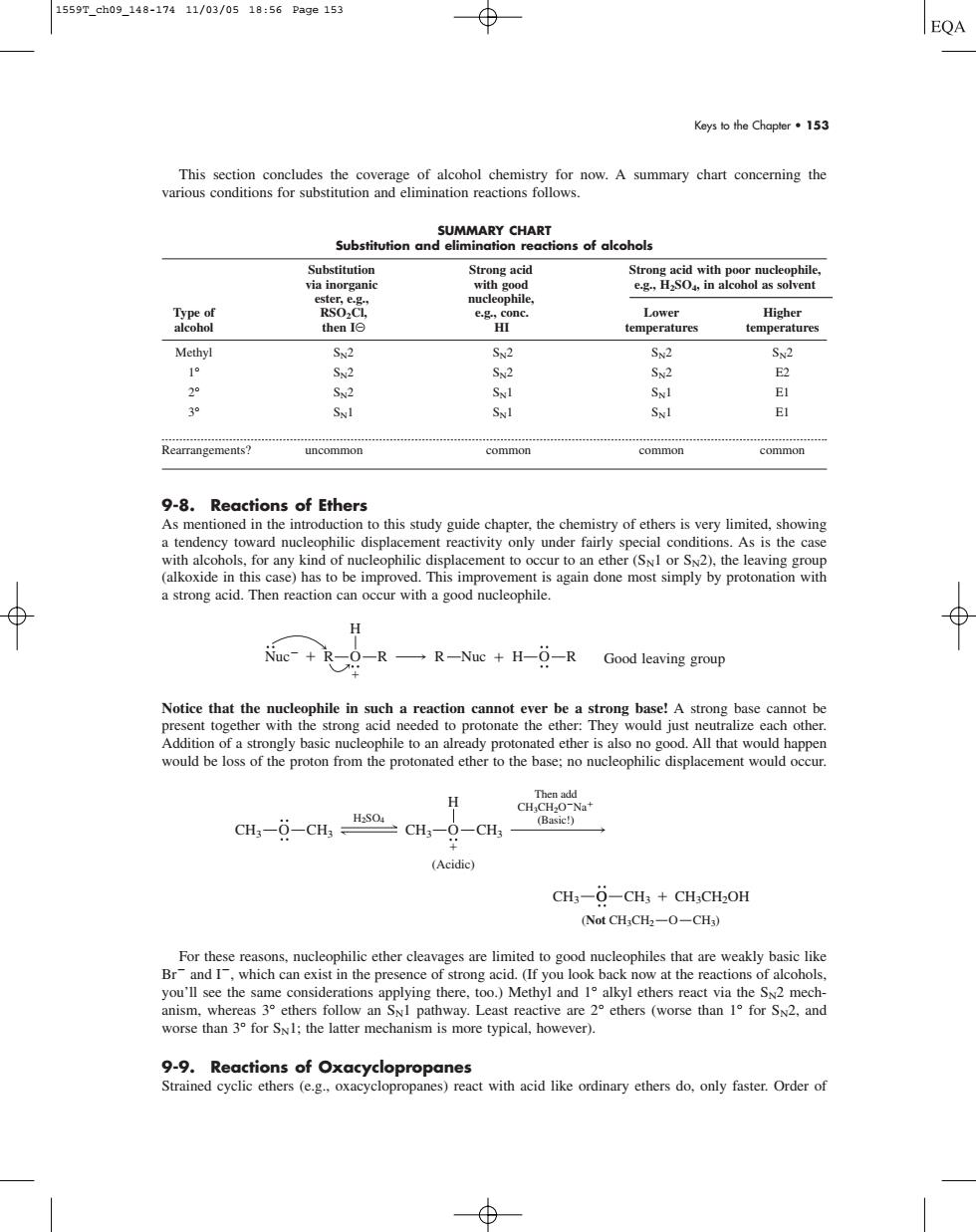正在加载图片...

1559T_ch09_148-17411/03/0518:56Pa9e15 ⊕ EQA Keys to the Chopler·153 ubs of alcohols gs8 Rearrangements? uncommon common common common 9-8.Reactions of Ethers As mentioned in the introduction to this study guide chapter,the chemistry of ethers is very limited,showing ard nuc displacemen reactivity only under fairly 21 As is the cas a strong acid.Then reaction can occur with a good nucleophile Nue-+R-R R-Nuc +H-6-R Good leaving group 一 CH-6-cH,soCH一-CH, CH3-O-CH,+CH;CH2OH (Not CH:CH2-0-CH3) For the s.nucleophilic ether cleay es are limited to good nucleophiles that are weakly basic like Brand which can exist in the presence of strong acid.(If you look back now at the reactions of alcohols you'll see the same onsid g there.too.)Methyl and alkyl ethers reactv worse thanfor S the latter mechanism is more typical,however). Keys to the Chapter • 153 This section concludes the coverage of alcohol chemistry for now. A summary chart concerning the various conditions for substitution and elimination reactions follows. SUMMARY CHART Substitution and elimination reactions of alcohols Substitution Strong acid Strong acid with poor nucleophile, via inorganic with good e.g., H2SO4, in alcohol as solvent ester, e.g., nucleophile, Type of RSO2Cl, e.g., conc. Lower Higher alcohol then IE HI temperatures temperatures Methyl SN2 SN2 SN2 SN2 1° SN2 SN2 SN2 E2 2° SN2 SN1 SN1 E1 3° SN1 SN1 SN1 E1 Rearrangements? uncommon common common common 9-8. Reactions of Ethers As mentioned in the introduction to this study guide chapter, the chemistry of ethers is very limited, showing a tendency toward nucleophilic displacement reactivity only under fairly special conditions. As is the case with alcohols, for any kind of nucleophilic displacement to occur to an ether (SN1 or SN2), the leaving group (alkoxide in this case) has to be improved. This improvement is again done most simply by protonation with a strong acid. Then reaction can occur with a good nucleophile. Good leaving group Notice that the nucleophile in such a reaction cannot ever be a strong base! A strong base cannot be present together with the strong acid needed to protonate the ether: They would just neutralize each other. Addition of a strongly basic nucleophile to an already protonated ether is also no good. All that would happen would be loss of the proton from the protonated ether to the base; no nucleophilic displacement would occur. For these reasons, nucleophilic ether cleavages are limited to good nucleophiles that are weakly basic like Br and I, which can exist in the presence of strong acid. (If you look back now at the reactions of alcohols, you’ll see the same considerations applying there, too.) Methyl and 1° alkyl ethers react via the SN2 mechanism, whereas 3° ethers follow an SN1 pathway. Least reactive are 2° ethers (worse than 1° for SN2, and worse than 3° for SN1; the latter mechanism is more typical, however). 9-9. Reactions of Oxacyclopropanes Strained cyclic ethers (e.g., oxacyclopropanes) react with acid like ordinary ethers do, only faster. Order of CH3 CH3 CH3 O CH3 O CH3) H Then add CH3CH2ONa H2SO4 (Basic!) O CH3 O CH3 (Acidic) CH3CH2OH (Not CH3CH2 O Nuc R O R R Nuc H R O H 1559T_ch09_148-174 11/03/05 18:56 Page 153������